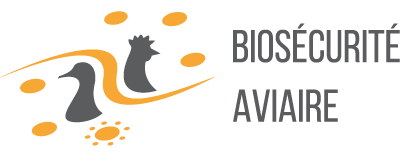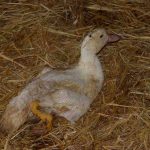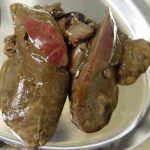Mobile salmonella including S. Enteritidis and S. Typhimurium are rare in poultry.
The disease agent and its pathogenicity
The nomenclature classifies them as Salmonella enterica subspecies enterica serovar Typhimurium (ST) and serovar Enteritidis (SE). These are mobile salmonella, called paratyphoid salmonella.
In general, salmonella are normal hosts of the digestive tract of animals and humans. In fact, SE and ST cause infections and portage, most often asymptomatic and persistent in poultry. The clinic appears in debilitated animals (youngs) or under particular stress.
The major antigens are the somatic antigen AgO (thermostable endotoxin), the flagellar antigen AgH (thermolabile, only present in mobile salmonella) and the virulence antigen Vi (thermolabile, it hides the AgO).
The pathogenicity will depend on the adherence to intestinal cells and their ability to invade them. It depends among other things on flagella, fimbriae and LPS.
Impacts on public health
Ubiquitous salmonellosis are the leading cause of collective food toxi-infection (CFTI). It is estimated that more than 70% of human salmonellosis is due to SE and ST. They cause gastroenteritis and sometimes septicaemia in the weakest subjects. There is a crossing through the intestinal barrier then passage into the blood and then into the other organs (arthritis, meningitis, hepatitis).
Collective food toxi-infections are mainly due to the consumption of eggs, and sometimes contaminated meat. Contamination of eggs takes place via the yolk (i.e. via the ovaries of the laying hen) or via contamination of the shell by faeces. Carcass contamination occurs at the slaughterhouse in scalding tanks or during evisceration.
Other important serovars: S. Hadar, S. Virchow and S. Infantis are also involved in CFTI, but to a lesser extent than S. Enteritidis and S. Tiphimurium.
Epidemiological data
- They are GRAM -, optional anaerobic bacteria with optimum growth at 37°C. Salmonella are hosts of the digestive tract and are found in very large quantities in droppings and therefore in the environment of animals. They can persist out of the sun and in humid conditions for several months to several years. All animals can be potential carriers, and insects and materials can act as carriers.
- The transmission can be direct or indirect, vertical, pseudo vertical or horizontal.
- Enteritidis (mainly) and Typhimurium (some subtypes) serovars have invasive properties that allow them to pass through the bloodstream, then into the ovaries and therefore directly into the egg yolk. The oviduct can be contaminated upwards. Contamination of the chick at hatching involves contamination of the shell. It is therefore a “pseudo-vertical” contamination.
- Salmonella(s) have significant resistance in the external environment : as some strains of Salmonella Enteritidis may have been revived after 26 months in the environment. In addition, these bacteria can be carried by poorly disinfected equipment, aerosols, birds, insects, or small mammals. All this causes horizontal contamination of Salmonella causinf re-occurrence ont the same farm or contamination on another contact farm.
- The virulence of SE and ST is mainly due to the adhesion of these bacteria to epithelial cells and secondarily to the production of endotoxins.
- Co-infections with coccidioses, immunosuppressive viral infections, stressful rearing conditions, low rearing temperatures are all risk factors facilitating Salmonella infection.
Clinical manifestations of the disease
A distinction is made between the infection and the disease. Salmonellosis infection results in a healthy carry without symptoms or lesions. The disease is expressed in young animals during or shortly after hatching.
Symptoms
Significant mortality and morbidity are observed during the first two weeks of life. The signs are similar to other salmonella infections (pullorosis, typhoid) : chicks are cold, snuggled up near heat sources, tousled and often die dehydrated. There are respiratory signs, decreased fitness, drowsiness, weight loss and whitish diarrhea that stick to the cloaca feathers, but also sometimes arthritis and omphalitis.
Lesions
When sepsis and death appear quickly, relatively few lesions are observed, but otherwise there are typical salmonellosis lesions, namely necrotic foci (intestines, liver, spleen), perihepatitis and fibrinous pericarditis, delayed absorption and lumpy yolk content. Caeca can be dilated with a caseous content. Kidneys are enlarged and urate crystals can be observed.
In mature animals, some SE can cause anorexia, diarrhea and a fall in egg laying.
The diagnosis
- It is done in a context of clinical signs (isolation and identification from heart, liver or yolk) or screening (box bottoms, dust, litter).
- In the regulatory framework, two enrichment media are used in approved laboratories ; the Muller Kauffman (MK) medium or the MSRV medium. Transplantation is then carried out on XLD agar and/or other specific media. Identification and serotyping are then performed. Serotyping is done by monospecific agglutination of the O and H antigens. The lysovar of the isolate can also be defined.
- ELISA tests exist and allow to have a result in 48 hours for a sensitivity of 98%.
- PCR method is possible but still expensive.
Disease prevention and control
Treatment
Apart from clinical salmonellosis, antibiotic treatments for Salmonella infections are prohibited in France. They reduce the portage without removing it.
It is interesting to note that the immune response of poultry for this disease is very effective, reducing the duration and intensity of clinical signs and the possibility of re-infection.
SE and ST are not very resistant to common disinfectants and heat. The application of good biosecurity practices is the major lever in the prevention of salmonella. It also includes proper manure and litter management, effective insect and rodent control, and proper disinfection of the batch and equipment between strips.
Vaccination
Vaccination is prohibited at the selection stage. Live vaccines are only allowed on flocks of future laying hens of table eggs in highly affected sites. Inactivated vaccines can be used on laying hens for human consumption eggs and on chickens and turkeys for meat and breeding stock (Gallus meat chain, breeding turkeys). The inactivated vaccine does not prevent the portage but limits contamination of the ovaries and therefore of the egg yolk.
Barrier flores are used as a spray on chicks during the first days of life, in order to provide them with a “safe” flora that competes with unwanted flores.
Since the decree of 24 2013, Salmonella from the serovars Thyphinurium, Enteritidis, Hadar, Infantis and Virchow have been 1st category health hazards for chicken and turkey, and 2nd category for other types of farms (especially breeding farms).
Controls are strict and constantly evolving. In breeding animals, if a positive analysis is confirmed, the herd is eliminated (eggs are eliminated or sanitized). In the meat chain if the control 3 weeks before slaughter is positive for SE or ST, animal health measures are taken to decontaminate the building and if there is detection in the muscle, the meat will be thermised before marketing.
